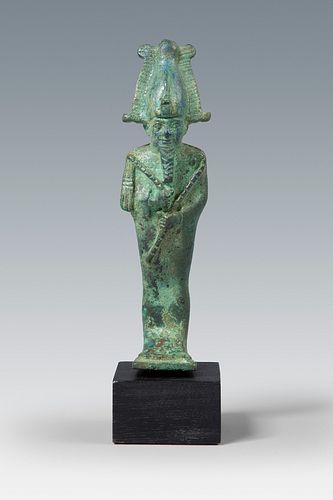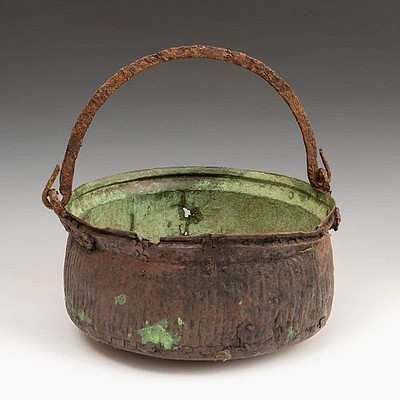God Osiris. Ancient Egypt, Lower Epoch (664-323 B.C.). Bronze. Provenance: private collection S.A., Cadiz, Spain. Intact. Measures: 10,7 x 12,5 cm
Lot 4
About Seller
Setdart Auction House
Carrer Aragó 346
Barcelona
Spain
Setdart Subastas was born in 2004 and is currently the first online art auction in Spain with solidity, prestige and reliability guaranteed by our more than 60,000 users. Setdart has a young, dynamic and enterprising team ready to successfully manage the purchase and sale of art works through custom...Read more
Estimate:
EUR€2,500 - EUR€2,800
$2,631.58 - $2,947.37
Absentee vs Live bid
Two ways to bid:
- Leave a max absentee bid and the platform will bid on your behalf up to your maximum bid during the live auction.
- Bid live during the auction and your bids will be submitted real-time to the auctioneer.
Bid Increments
| Price | Bid Increment |
|---|---|
| EUR€0 | EUR€10 |
| EUR€200 | EUR€25 |
| EUR€500 | EUR€50 |
| EUR€1,000 | EUR€100 |
| EUR€3,000 | EUR€200 |
| EUR€5,000 | EUR€500 |
| EUR€10,000 | EUR€1,000 |
| EUR€20,000 | EUR€2,000 |
| EUR€50,000 | EUR€5,000 |
About Auction
By Setdart Auction House
Dec 22, 2021
Set Reminder
2021-12-22 08:30:00
2021-12-22 08:30:00
America/New_York
Bidsquare
Bidsquare : Archaeology, Session I
https://www.bidsquare.com/auctions/setdart-auction-house/archaeology-session-i-8050
Setdart Auction House sofia@setdart.com
Setdart Auction House sofia@setdart.com
- Lot Description
God Osiris. Ancient Egypt, Lower Epoch (664-323 B.C.). Bronze. Provenance: private collection S.A., Cadiz, Spain. Intact. Measures: 10,7 x 12,5 cm. Statuette of round bulk representing the God Osiris carrying the Heka and the Nekhakha. The God is standing, with his arms crossed over his chest and a series of characteristic elements, such as the Atef crown (a more complex typology of the White crown that is composed of two ostrich feathers, sometimes with two horns at its base, uraeus and a solar disk. It is represented in yellow color and it was thought to help the deceased to be reborn, attribute for which it is carried by the god Osiris). The piece also presents the arms crossed on the chest, with which it holds the whip and the callado, which are two of its main iconographic symbols. Osiris is the Egyptian god of resurrection, related to fertility and regeneration of the Nile, protector of vegetation and agriculture. He also presides over the court of judgment of the dead, and is in fact closely related to the Afterlife. He was considered the firstborn son of Geb, divinity of the earth, and the goddess Nut, representation of the sky. He was therefore brother and husband of Isis, with whom he had a posthumous son, Horus. We find him for the first time in the sources of the V dynasty, although it is most likely that he was worshipped long before. In fact, we find the epithet Khenti-Amentiu ("leader of the Orientals", alluding to his role as king of the Beyond) already used in the I dynasty, both in relation to the divinity and as a pharaonic title. The most valuable information about Osiris is found in the Pyramid Texts of the late V dynasty, the Shabaka Stone of the New Empire and, much later, in the texts of Greek writers such as Plutarch or Diodorus.
- Shipping Info
-
In-house shipping available. Please inquire at admin@setdart.com.
-
- Buyer's Premium



 EUR
EUR CAD
CAD AUD
AUD GBP
GBP MXN
MXN HKD
HKD CNY
CNY MYR
MYR SEK
SEK SGD
SGD CHF
CHF THB
THB













